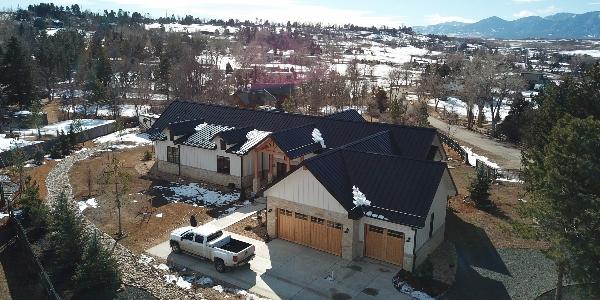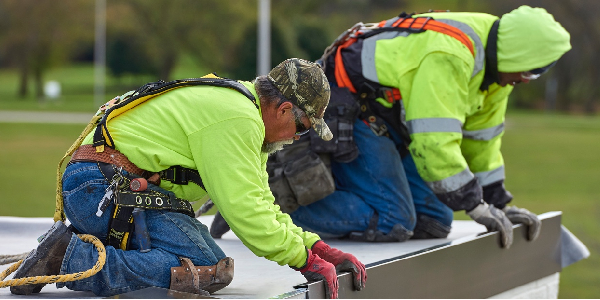Shielding homes from the storm

By Drexel Metals.
Understand the unmatched durability of metal roofing against extreme weather in the United States.
The U.S. continues to experience a lot of severe weather events due to its geography, and they appear to be getting worse each year.
“Blame geography for the U.S. getting hit by stronger, costlier, more varied and more frequent extreme weather” reports a contributor to PBS News Hour. Two oceans, the Gulf of Mexico, the Rocky Mountains, jutting peninsulas like Florida, clashing storm fronts, and the jet stream combine to brew the nastiest of weather naturally.”
Extreme weather events, such as powerful hurricanes, severe hail and scorching heat waves, have increased the complexity of roofing construction projects, necessitating the use of materials that can withstand these weather events. Metal roofs are great for areas that experience severe weather because they are very durable, and can stand up to strong winds, fires, rain and sun damage.
But what makes metal roofs able to be so protective against these weather events from Mother Nature? Let's explore the reasons.
Metal roofing delivers enhanced wind resistance
While metal roofing systems provide many forms of weathertight protection, the ability to withstand high winds is arguably one of their most critical benefits. In fact, metal roofs provide wind resistance of up to 120 miles per hour. Unlike other roofing systems, panelized metal roofing systems extend from eave to ridge and interlock with adjacent panels to minimize the points where gusts of winds can lift and damage the roof. Metal also has a substantial strength-to-weight ratio. This means individual panels can withstand direct wind without increasing the overall weight of a roof. It also means that the places where panels interlock have the strength to endure extreme wind forces.
Noncombustible metal roofing systems tested to resist the spread of fire
Wildfires — especially during the hot and dry summer months — are one of the most common extreme weather events dominating today’s headlines. When it comes to examining the fire preparedness of a roofing system, a metal substrate provides the first layer of defense against fire. Whether made from steel, copper or aluminum, metal roofs can achieve UL 263 Class A fire resistant ratings, the highest ranking possible. This means metal roofs can effectively resist the spread of fire and will not contribute any fuel to the blaze.
Impervious to moisture, metal panels offer wet weather performance
Traditional roofing materials, like asphalt shingles and clay tiles, are porous. These materials will quickly absorb water, which can cause major problems down the road for structures in locations that experience increasing amounts of rain and snowfall. However, metal roofing provides reliable wet-weather performance due to its inherently durable substrate impervious to moisture. A metal roof’s weathertight performance can be enhanced with a proper underlayment and an advanced coating or paint finish. Moreover, many of Drexel Metals’ roofing systems are eligible for a 20-year Weather Tightness Warranty, which guarantees a seam will not leak or otherwise fail.
High-performance metal roofing finishes protect against damaging UV rays
Sure, metal roofing can deliver proven performance in the face of today’s extreme weather scenarios — but its ability to deliver function and form is what truly sets it apart. To ensure customers receive the full longevity and beauty of a metal roofing system, most metal roofing fabricators will use a high-performance finish like PVDF. A type of resin, PVDF’s strong chemical bonds resist the damaging effects of long-term sun exposure, making it possible for a roof to maintain its original color over its service life. A metal roof’s fade resistance is bolstered by PVDF’s ability to curb long-term chalking, which refers to the appearance of a powdery white residue on the surface of a coating. This phenomenon happens when resins in coatings break down and degrade after years of exposure to harmful UV rays. The loss of the protective layer will not only dull the roof color, but it will also compromise the integrity of the metal underneath.
Metal roofs ensure long-term protection against the elements
Tested to withstand high winds, fire, moisture absorption and the effects of harmful UV rays, a metal roof’s resilience is why it can last up to three times longer than traditional roofing materials. Because metal roofs provide long-term protection against the elements with minimal associated maintenance, they are considered more cost-effective in the long term compared to their natural slate, asphalt or wood counterparts.
Original article source: Drexel Metals
Learn more about Drexel Metals in their Coffee Shop Directory or visit www.drexmet.com.
About Jonny
Jonny Suchor is a writer for the Coffee Shops and AskARoofer™. When he's not working, he can be found in the mountains on a fly fishing or skiing adventure.























Comments
Leave a Reply
Have an account? Login to leave a comment!
Sign In